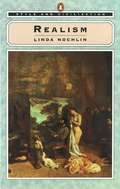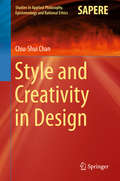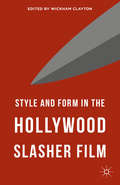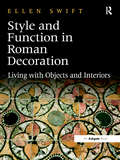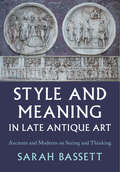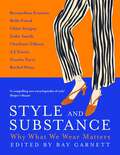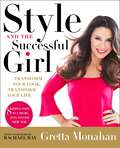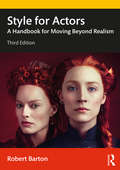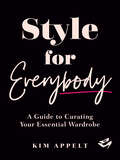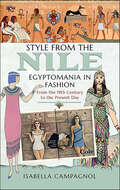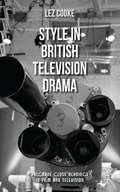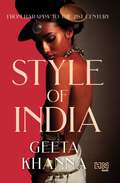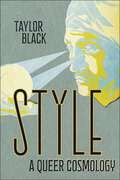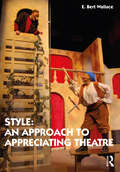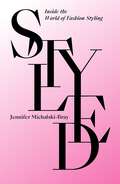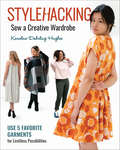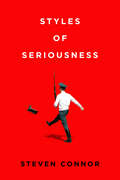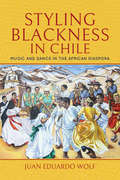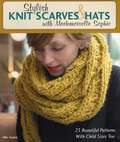- Table View
- List View
Style and Civilization: Realism
by Linda NochlinSetting Realism in its social and historical context, the author discusses the crucial paradox posed by Realist works of art - notably in the revolutionary paintings of Courbet, the works of Manet, Degas and Monet, of the Pre-Raphaelites and other English, American, German and Italian Realists.
Style and Creativity in Design
by Chiu-Shui ChanThis book looks at causative reasons behind creative acts and stylistic expressions. It explores how creativity is initiated by design cognition and explains relationships between style and creativity. The book establishes a new cognitive theory of style and creativity in design and provides designers with insights into their own cognitive processes and styles of thinking, supporting a better understanding of the qualities present in their own design. An explanation of the nature of design cognition begins this work, with a look at how design knowledge is formulated, developed, structured and utilized, and how this utilization triggers style and creativity. The author goes on to review historical studies of style, considering a series of psychological experiments relating to the operational definition, degree, measurement, and creation of style. The work conceptually summarizes the recognition of individual style in products, as well as the creation of such styles as a process before reviewing studies on creativity from various disciplines, presenting case studies and reviewing works by master architects. Readers will discover how creativity is initiated by design cognition. A summary of the correlations between creativity and style, expressed as a conceptual formula describing the cognitive phenomenon of style and creativity concludes the work. The ideas presented here are applicable to all design fields, allowing designers to comprehend and improve their design processes to produce creative, stylistically unique products.
Style and Faith
by Geoffrey HillSeven essays on the moral life of literature and the moral burden of the poet seek to rescue key literary works from misinterpretation, in a collection that covers such texts as the Oxford English Dictionary, Tyndale's Bible, and poems by Henry Vaughan and T.S. Eliot.
Style and Form in the Hollywood Slasher Film
by Wickham ClaytonStyle and Form in the Hollywood Slasher Film fills a broad scholastic gap by analysing the elements of narrative and stylistic construction of films in the slasher subgenre of horror that have been produced and/or distributed in the Hollywood studio system from its initial boom in the late 1970s to the present.
Style and Function in Roman Decoration: Living with Objects and Interiors
by Ellen SwiftThis important book puts forward a new interpretation of Roman decorative art, focusing on the function of decoration in the social context. It examines the three principal areas of social display and conspicuous consumption in the Roman world: social space, entertainment, and dress, and discusses the significance of the decoration of objects and interiors within these contexts, drawing examples from both Rome and its environs, and the Western provinces, from the early Imperial period to Late Antiquity. Focusing on specific examples, including mosaics and other interior décor, silver plate, glass and pottery vessels, and jewellery and other dress accessories, Swift demonstrates the importance of decoration in creating and maintaining social networks and identities and fostering appropriate social behaviour, and its role in perpetuating social convention and social norms. It is argued that our understanding of stylistic change and the relationship between this and the wider social context in the art of the Roman period is greatly enhanced by an initial focus on the particular social relationships fostered by decorated objects and spaces. The book demonstrates that an examination of so-called 'minor art' is fundamental in any understanding of the relationship between art and its social context, and aims to reinvigorate debate on the value of decoration and ornament in the Roman period and beyond.
Style and Meaning in Late Antique Art: Ancients and Moderns on Seeing and Thinking
by Sarah BassettHow do we best see and understand the art of late antiquity? One of the perceived challenges of so doing is that this is a period whose visual production has been defined as stylistically abstract and emotionally spiritual, and therefore elusive. But this is a perception which – in her path-breaking new book – Sarah Bassett boldly challenges, offering two novel lines of interpretative inquiry. She first argues, by focusing on the art of late antiquity in late nineteenth-century Viennese intellectual and artistic circles, that that period's definition of late antique form was in fact a response to contemporaneous political concerns, anticipating modernist thinking and artistic practice. She then suggests that late antique viewers never actually abandoned a sense of those mimetic goals that characterized Greek and Roman habits of representation. This interpretative shift is transformative because it allows us to understand the full range and richness of late antique visual experience.
Style and Substance: Why What We Wear Matters
by Bay Garnett'Completely riveting . . . an eclectic compendium of style, subversion and literary snippets . . . all about the magical meaning of clothes'CALENDAR MAGAZINEMaya Angelou imagined she'd feel like a movie star in a dress of lavender taffeta. Rachel Weisz loves the democracy of denim. Zadie Smith's look differs depending on whether she's in New York or London, while Joan Didion always packed the same clothes. Jarvis Cocker found inspiration at jumble sales, Bella Freud in Colette's novels and Harris Reed in the gender fluidity of Virginia Woolf's Orlando. Oscar Wilde understood the importance of proportions, Stanley Tucci favours a narrow stripe and Chloë Sevigny delights in traditional, with a twist. For Bernardine Evaristo style is about a refusal to be stereotyped. Jilly Cooper and AJ Tracey appreciate retail therapy. Sienna Miller misses the freedom of a less self-conscious age. For Davina McCall, an outfit begins with underwear; for Sophie Dahl it's not complete without scent. Clothes allow Susie Cave to hide and Charlotte Tilbury to feel empowered.With over sixty pieces on everything from thrifting to modesty dressing, drag to vintage sportswear, Style and Substance is a gloriously eclectic celebration of self-expression.
Style and the Successful Girl: Transform Your Look, Transform Your Life
by Gretta MonahanForeword by Rachael RayDress for success: A renowned television beauty and fashion guru provides women with a head-to-toe makeover for projecting—and attracting—success at every turn. Transform your style, transform your life: Gretta Monahan is Rachael Ray’s on-air resident style, beauty, and fashion consultant, with a host of celebrity clients who rely on her expertise to stay on the A-list. However, Gretta’s style principals aren’t just for celebrities—anyone can learn how to dress for success in their work or personal life.Making Gretta’s winning approach available to all, Style and the Successful Girl is both a style guide and a full-color fashion book, packed with stories, sidebars, and photos to help every reader discover and create her own style visions. From choosing the right undergarment to accessories and work attire, Gretta demonstrates not only how to fashion a wardrobe but also how to use your clothes to communicate confidence and style.
Style for Actors: A Handbook for Moving Beyond Realism
by Robert BartonStyle for Actors is an award-winning handbook and the definitive guide to roles in historical drama. Anyone who has ever struggled with capes, fans, swords, doublets and crinolines should make this third edition their constant companion. The past is a foreign country, and this outstanding book is concerned with exploring it from the actor's point of view. Specific guides to each major period give readers a clear map to discover a range from Greek, Elizabethan, Restoration and Georgian theatre to more contemporary stylings, including Futurism, Surrealism and Postmodernism. New material in this edition covers Commedia dell'arte and non-Western forms of theatre, theatrical fusion and developments in musicals and Shakespeare. The book’s references, images, resource lists and examples have all been updated to support today's diverse performers. Robert Barton takes great care to present the actor with the roles and genres that will most commonly confront them. Containing a huge resource of nearly 150 exercises, suggestions for scene study and applications not only for theatrical performance but also for stylistic challenges in the reader’s own offstage life, this book is an invaluable resource for students and practitioners of acting and drama.
Style for Everybody: A Guide to Curating Your Essential Wardrobe
by Kim AppeltThe go-to fashion roadmap sharing the secrets to building a capsule wardrobe for all body shapes and personal styles.We&’ve all felt that defeat: thumbing through blouse after blouse in your closet, feeling like you have absolutely nothing to wear. Or at least, nothing you feel good in. That&’s where Style for Everybody comes in. Kim Appelt is a stylist to the stars, and while her chic looks dazzle at award shows and beyond, she knows life&’s not all about being red carpet ready. Building on the fun, approachable style wisdom from her popular YouTube videos, Style for Everybody is the go-to book for creating a classic and timeless wardrobe to perfectly fit you—your body, your style, and your life.With Kim&’s guidance, you&’ll learn how to:Condense your current closet with sustainable donation suggestionsDetermine your body shape and personal styleShop with efficiency and purposeAnd the moment you&’ve been waiting for! Build a new curated wardrobe, focusing on key garments, shoes, purses, and accessories for each body type and styleWith an understanding of versatile body shapes (hourglass and rectangles are only the beginning) and fashion styles (a little preppy, full-on edgy?), Kim knows that the better you feel about yourself, the more of a positive force you can be in the world. Filled with beautiful illustrations, Style for Everybody is like having a personal stylist (and cheerleader!) in your home—and Kim&’s help and encouragement will keep coming back whenever you need a style pick-me-up.
Style from the Nile: Egyptomania in Fashion From the 19th Century to the Present Day
by Isabella CampagnolIn November 1922, the combined efforts of Howard Carter and Lord Carnarvon revealed to the world the 'wonderful things' buried in Tutankhamen’s tomb, Egypt had already been a source for new trends in fashion for quite some time: in the early 19th century, for example, Napoleon’s Egyptian campaign contributed to the popularization of Kashmir shawls, while the inauguration of the Suez Canal in 1869 stimulated 'Egyptianizing' trends in gowns, jewellery and textiles. Post-1922, a veritable Egyptomania craze invested all artistic fields, quickly becoming a dominant Art Deco motif: “flapper-style” dresses were elaborately embroidered with beaded “Egyptian” patterns, evening bags were decorated with hieroglyphics, brooches nonchalantly sported ancient scarabs, and the sleek black bobs favored by the admired icons of the time, Louise Brooks and Clara Bow, looked up to the fabled Egyptian beauty of Nefertiti and Cleopatra. Egyptomania often resurfaces in 21st-century fashion as well: the awe-inspiring John Galliano’s designs for Dior Spring-Summer 2004 brought back pharaonic crowns in lieu of headdresses in a triumph of gold-encrusted creations, the ancient practice of mummification was referenced by Iris van Herpen’s Fall 2009 collection and Egyptian vibes resonated in Chanel's Métiers d’Art 2018/2019 collection. Through the combination of rigorous fashion history research, intriguing images and well-informed, but approachable, writing, Style from the Nile offers a comprehensive overview of a fascinating phenomenon that, to this day, continues to have a mesmerizing appeal.
Style in British Television Drama (Palgrave Close Readings in Film and Television)
by Lez CookeThis pioneering book provides detailed analysis of scenes from nine British television dramas produced between 1954 and 2001. Taking dinner table scenes as a recurring motif, the study analyses changes in televisual style with reference to production practices, technology, aesthetic preferences, and social and institutional change.
Style of India
by Geeta KhannaA stunning visual view of the evolution of style in India, this spectacular volume traverses an incredible breadth of history, offering a panoramic view of the defining moments - the cultural factors, historical compulsions and mystical concepts - that have intersected over time and propelled the evolution of style in the country over millennia. Bringing together over 100 stunning visuals from archival material and gorgeous recreations of drapes and accessories over centuries, accompanied by perceptive essays, this unique book weaves a compelling chronicle from pre-history and the Harappan civilization to the era of Hindi cinema and contemporary Indian fashion to throw a spotlight on the unique story of Indian style. An unforgettable pictorial journey through the history of style in India, this work is a must-have for style connoisseurs, aspiring designers and students of fashion design for years to come.
Style, Stitch, Staple: Basic Upholstering Skills to Tackle Any Project
by Hannah StantonRevive your living room with these straightforward upholstery techniques
Style: A Queer Cosmology (Postmillennial Pop #37)
by Taylor BlackAssembles texts, performances, and personae from American culture to assert the elemental natureof styleWhile “style” is equated with fashion or convention in common parlance, Style: A Queer Cosmology defines the term as a mode of expression that makes us more like ourselves and less like everyone else. Taylor Black’s interdisciplinary conceptual analysis assembles texts, performances, and personae from American culture that engage in ethical, creative, and performative modes of what he terms “abundant revelation.” Moving back and forth through time, this book sketches American cosmologies cultivated by iconic and subterranean American artists like Edgar Allan Poe, Flannery O’Connor, Nikki Giovanni, and Bob Dylan. Presiding throughout is the book’s conceptual guide: latter-day American and notorious homosexual Quentin Crisp, resurrected here as a philosopher of style.As a scholarly intervention, Style participates in the critical work of revival and attunement—revitalizing figures, terms, and ideas that have become too familiar. Returning to viewing the critic as a stylist, Style: A Queer Cosmology leans into the study of things and qualities that are immanent and elude paraphrase or social scientific categorization. Style is about the possible rather than the probable, singularity over universals, personality instead of identity, the emergent and not the new—the mystery of becoming.
Style: An Approach To Appreciating Theatre
by E. Bert WallaceStyle: An Approach to Appreciating Theatre offers brief, readable chapters about the basics of theatre as a starting point for discussion, and provides new adaptations of classic plays that are both accessible to students learning about theatre and fit for production. In this text, style is the word used to describe the various ways in which theatre is done in real space and time by humans in the physical presence of other humans. The book uses style, the "liveness" of theatre that makes it distinct from literature or history, as a lens to see how playwrights, directors, designers, and actors bring scripts to life on stage. Rather than focusing on theatre history or literary script analysis, it emphasizes actual theatrical production through examples and explores playscripts illustrating four theatrical styles: Realism, Theatricalism, Expressionism, and Classicism. Susan Glaspells Realistic play Trifles is presented as written, while The Insect Play by the Brothers apek, The Hairy Ape by Eugene ONeill, and Antigone by Sophocles are original, full-length adaptions. Style: An Approach to Appreciating Theatre is the perfect resource for students of Theatre Appreciation, Introduction to Theatre, Theatrical Design, and Stagecraft courses.
Styled: Inside the World of Fashion Styling
by Jennifer Michalski-BrayIn a world awash with influencers sharing videos of their hottest new looks, how do you become a trusted name in fashion or a bonafide stylist to the stars? What skills are needed to curate the image of a wide range of clients, to style a fashion shoot for an influential publication or to design the costumes for a hit show? And what professional styling tips can all fashion lovers apply to their own outfits?Jennifer Michalski-Bray leads the reader behind the scenes of celebrity styling, commercial styling, editorial styling and costume design, and shows aspiring stylists how to build their brand. The book is fully illustrated, includes interviews with other successful fashion professionals and celebrities, and an array of helpful resources: quizzes; toolkit; glossary; and conversion charts.
Styled: Inside the World of Fashion Styling
by Jennifer Michalski-BrayIn a world awash with influencers sharing videos of their hottest new looks, how do you become a trusted name in fashion or a bonafide stylist to the stars? What skills are needed to curate the image of a wide range of clients, to style a fashion shoot for an influential publication or to design the costumes for a hit show? And what professional styling tips can all fashion lovers apply to their own outfits?Jennifer Michalski-Bray leads the reader behind the scenes of celebrity styling, commercial styling, editorial styling and costume design, and shows aspiring stylists how to build their brand. The book is fully illustrated, includes interviews with other successful fashion professionals and celebrities, and an array of helpful resources: quizzes; toolkit; glossary; and conversion charts.
Styled: Secrets for Arranging Rooms, from Tabletops to Bookshelves
by Emily Henderson Angelin BorsicsThe ultimate guide to thinking like a stylist, with 1,000 design ideas for creating the most beautiful, personal, and livable roomsIt's easy to find your own style confidence once you know this secret: While decorating can take months and tons of money, styling often takes just minutes. Even a few little tweaks can transform the way your room feels. At the heart of Styled are Emily Henderson's ten easy steps to styling any space. From editing out what you don't love to repurposing what you can't live without to arranging the most eye-catching vignettes on any surface, you'll learn how to make your own style magic. With Emily's insider tips and more than 1,000 unique ideas from 75 envy-inducing rooms, you'll soon be styling like you were born to do it.
Stylehacking, Sew a Creative Wardrobe: Use 5 Favorite Garments for Limitless Possibilities
by Karoline Dahrling HughesLearn how you can turn your clothing basics into a stylish wardrobe with this quick & simple guide for sewing beginners and more experienced sewists.Get inspired to elevate your wardrobe with dozens of tips and tricks on creating handmade, fashionable creating fashionable, wardrobe pieces. Dream about it one day and wear it the next. Take the essentials found in every closet (a camisole, a tee, a jumper, a pair of trousers, and leggings) and learn how to transform them into something new. Advice ranges from hemming and elastic techniques, stitch and fabric guides, and basic sewing principles. Perfect for sewing beginners looking to conquer clothing, you'll learn how to sew a top, trousers, skirts, and other fashion favorites. Also great for more experienced sewists looking to get creative with new timesaving garment tricks. All creatives can find something to design with 30+ wardrobe ideas from basic tee dress to cardigans, kimonos, bike shorts, and so much more. Stylehacking is made for every sewist to succeed—there is no time spent on measuring, on decrypting the lines on paper patterns, or altering premade patterns. · Take 5 basic pieces (tank top, t-shirt, sweater, trousers, and leggings) from your closet to make templates from which you can create an endless variety of garments· Includes over 30 styles to get creative with· Stylehacking is easy! No paper patterns, no sizing, and no fuss
Styles of Seriousness
by Steven ConnorBeing serious demands serious kinds of work. In Styles of Seriousness, Steven Connor reflects on the surprisingly various ways in which a sense of the serious is made and maintained, revealing that while seriousness is the most powerful feeling, it is also the most poignantly indeterminate, perhaps because of the impossibility of being completely serious. In colloquy with philosophers such as Aristotle, Nietzsche, James, Sartre, Austin, Agamben and Sloterdijk, and writers like Shakespeare, Byron, Auden and Orwell, Connor considers the linguistic and ritual behaviors associated with different modes of seriousness: importance; intention, or ways of really "meaning things;" sincerity; solemnity; urgency; regret; warning; and ordeal. The central claim of the book is human beings are capable of taking things seriously in a way that nonhuman animals are not, for the unexpected reason that human beings are so much more versatile than most animals at not being completely serious. One always, in fact, has a choice about whether or not to take seriously something that is supposed to be so. As a consequence, seriousness depends on different kinds of formalization or stylized practice. Styles of seriousness matter, Connor shows, because human beings are incapable of simply and spontaneously existing. Being a human means having to take seriously one's style of being.
Styling Blackness in Chile: Music and Dance in the African Diaspora
by Juan Eduardo WolfChile had long forgotten about the existence of the country’s Black population when, in 2003, the music and dance called the tumbe carnaval appeared on the streets of the city of Arica. Featuring turbaned dancers accompanied by a lively rhythm played on hide-head drums, the tumbe resonated with cosmopolitan images of what the African Diaspora looks like, and so helped bring attention to a community seeking legal recognition from the Chilean government which denied its existence. Tumbe carnaval, however, was not the only type of music and dance that Afro-Chileans have participated in and identified with over the years. In Styling Blackness in Chile, Juan Eduardo Wolf explores the multiple ways that Black individuals in Arica have performed music and dance to frame their Blackness in relationship to other groups of performers—a process he calls styling. Combining ethnography and semiotic analysis, Wolf illustrates how styling Blackness as Criollo, Moreno, and Indígena through genres like the baile de tierra, morenos de paso, and caporales simultaneously offered individuals alternative ways of identifying and contributed to the invisibility of Afro-descendants in Chilean society. While the styling of the tumbe as Afro-descendant helped make Chile’s Black community visible once again, Wolf also notes that its success raises issues of representation as more people begin to perform the genre in ways that resonate less with local cultural memory and Afro-Chilean activists’ goals. At a moment when Chile’s government continues to discuss whether to recognize the Afro-Chilean population and Chilean society struggles to come to terms with an increase in Latin American Afro-descendant immigrants, Wolf’s book raises awareness of Blackness in Chile and the variety of Black music-dance throughout the African Diaspora, while also providing tools that ethnomusicologists and other scholars of expressive culture can use to study the role of music-dance in other cultural contexts.
Styling with Salvage: Designing And Decorating With Reclaimed Materials
by Joanne PalmisanoJoanne Palmisano is passionate about the joy and importance of reuse in home decor. Whether it's reclaimed, repurposed, recycled, salvaged, or antique, Joanne will show you how to turn an old piece into a stunning decorative object. Styling with Salvage is an essential guide for those who can't walk by a secondhand store or salvage yard without taking a peek, or who just want to decorate in a more mindful way. Joanne provides an aspirational-but-achievable template for all who wish to bring some character, style, and soul into their home.
Stylish Knit Scarves & Hats with Mademoiselle Sophie
by Mlle. SophieClassic international style makes these 23 fresh, modern designs versatile additions to your wardrobe, equally stylish for park, classroom, or office.Easy-to-knit patterns for scarves and cowls, hats, mittens, shawls, and more--all with appealing style and flairMany designs include both an adult and child size. Make a matching set!Step-by-step illustrated instructions for basic knitting stitches and simple, quick-knit patterns make this a great book for new knitters
Stylish Skirts
by Sato WatanabeStylish Skirts is the English edition of a popular Japanese sew-it-yourself fashion book which allows you to create simple yet stylish skirts that look and feel great-at a fraction of the cost of store-bought fashion. With this book, there's no end to the kinds of skirts you can create to match your body shape, your taste in fabrics and colors, and your mood (not to mention your favorite tops, shoes and accessories)! The instructions and diagrams are a snap to follow and provide a huge variety of styles-from ultra-feminine to artfully disheveled. All 23 skirt designs in this book look great in different fabrics, colors, prints and textures-so the options are truly endless. The enclosed patterns and instructions make cutting and sewing these skirts a breeze. Author Sato Watanabe has written many of the most popular Japanese sewing books on the market. In this new book, she shows you how to make professional-quality skirts easily and inexpensively at home. She studied clothing and accessory design at Tokyo's famous Bunka Fashion College before beginning a career as a magazine editor, eventually turning her writing skills to creating bestselling books!
